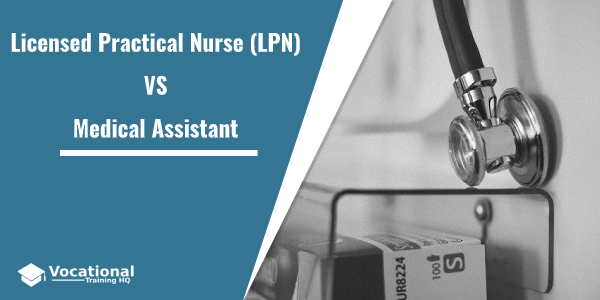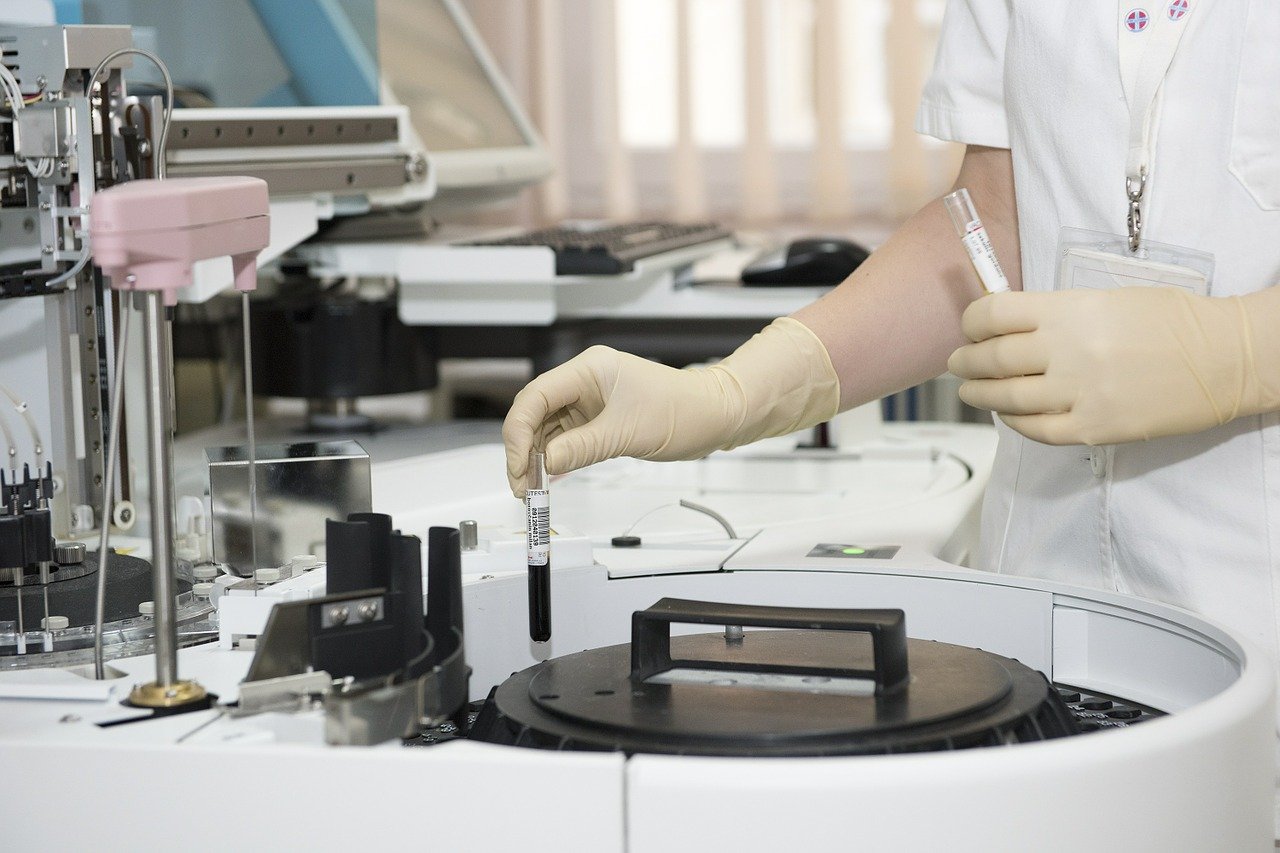When choosing a career in the field of nursing, many students don’t know the difference between a licensed practical nurse and a medical assistant.
Some responsibilities are common for both professions, but there are some vast differences in the job description, educational requirements, and salary for medical assistants and LPNs.
In general, LPNs are responsible for providing direct patient care while medical assistants handle some administrative duties such as preparing insurance paperwork or scheduling appointments.
They also deal with basic clinical tasks, e.g., taking vital signs of patients.
LPNs are also supervised by registered nurses or physicians, unlike medical assistants.
Job settings and working hours are also different for LPNs and medical assistants.
LPNs are often employed by nursing homes, and hospitals, or provide home care to clients with ranging shifts and hours.
Medical assistants, on the other hand, usually work in ambulatory clinics or physicians’ offices with more traditional hours.
Article Table of Contents
- 1 Medical Assistant vs. LPN Education
- 2 Medical Assistant vs. LPN Salary
- 3 Medical Assistant vs. LPN Job Duties
- 4 Medical Assistant vs. LPN Licensing & Certification
- 5 How Does a Medical Assistant Become an LPN?
- 6 Is There Any Medical Assistant to LPN Bridge Programs?
- 7 How Long is an LPN Program if Courses Can be Transferred?
- 8 What Types of Schools Offer an MA to LPN Program?
Medical Assistant vs. LPN Education
When choosing a career path, you need to know the difference between the education requirements for an LPN or medical assistant.
Sometimes, medical assistants can begin their careers only with a high school diploma without additional training.
In this case, they will have to find a position with a physician who is willing to train the employee.
However, employers usually look for medical assistants with formal training.
Many community colleges and technical schools offer medical assistant training programs, which generally take one to two years to complete.
Depending on the school, students may be able to earn a diploma in as little as nine months or an associate’s degree in 18-24 months.
Students can often choose from online programs, traditional in-person classroom programs, or a combination of the two.
Because licensure is not required to work as a medical assistant, aspiring medical assistants can begin working as soon as they have completed their training program.
On the other hand, LPNs need to complete a formal training program, which usually lasts for 12 months.
Just like medical assistants, LPNs can take programs at technical schools or community colleges.
However, most of their training should be completed in person.
Medical assistants’ coursework is mostly related to administrative duties (bookkeeping, insurance, etc.), as well as clinical tasks.
LPNs, though, focus more on clinical skills for providing care for patients.
LPNs are also required to pass the NCLEX-PN (National Council Licensure Examination).
After passing the exam, they can start working as LPNs.
Medical Assistant vs. LPN Salary
As of May 2016, the mean annual salary for medical assistants was $32,850, according to the data of the Bureau of Labor Statistics.
LPNs, on the other hand, made $44,840 per year.
The salary can be influenced by a number of factors, including the employer, location, as well as the level of education and experience.
For example, LPNs or medical assistants can make a higher income if they work in the area with higher living costs, or if they have a few years of experience.
Comparing Medical Assistant & LPN/LVN Salary By State
Alabama:
- Medical assistant – $27,280.
- LPN – $36,300.
- Increase – 33.1%.
Alaska:
- Medical assistant – $41,340.
- LPN – $53,760.
- Increase – 30.0%.
Arizona:
- Medical assistant – $32,970.
- LPN – $51,670.
- Increase – 56.7%.
Arkansas:
- Medical assistant – $30,160.
- LPN – $36,800.
- Increase – 22.0%.
California:
- Medical assistant – $36,620.
- LPN – $52,670.
- Increase – 43.8%.
Colorado:
- Medical assistant – $34,510.
- LPN – $48,690.
- Increase – 41.1%.
Connecticut:
- Medical assistant – $36,090.
- LPN – $55,720.
- Increase – 54.4%.
Delaware:
- Medical assistant – $31,630.
- LPN – $50,330.
- Increase – 59.1%.
District of Columbia:
- Medical assistant – $39,500.
- LPN – $55,200.
- Increase – 39.7%.
Florida:
- Medical assistant – $31,080.
- LPN – $42,960.
- Increase – 38.2%.
Georgia:
- Medical assistant – $30,830.
- LPN – $40,250.
- Increase – 30.6%.
Hawaii:
- Medical assistant – $35,450.
- LPN – $48,980.
- Increase – 38.2%.
Idaho:
- Medical assistant – $31,150.
- LPN – $40,680.
- Increase – 30.6%.
Illinois:
- Medical assistant – $32,920.
- LPN – $48,070.
- Increase – 46.0%.
Indiana:
- Medical assistant – $30,740.
- LPN – $41,540.
- Increase – 35.1%.
Iowa:
- Medical assistant – $32,920.
- LPN – $40,710.
- Increase – 23.7%.
Kansas:
- Medical assistant – $29,900.
- LPN – $40,880.
- Increase – 36.7%.
Kentucky:
- Medical assistant – $29,900.
- LPN – $39,460.
- Increase – 32.0%.
Louisiana:
- Medical assistant – $27,350.
- LPN – $38,070.
- Increase – 39.2%.
Maine:
- Medical assistant – $32,760.
- LPN – $43,680.
- Increase – 33.3%.
Maryland:
- Medical assistant – $35,030.
- LPN – $51,980.
- Increase – 48.4%.
Massachusetts:
- Medical assistant – $38,990.
- LPN – $55,190.
- Increase – 41.5%.
Michigan:
- Medical assistant – $30,490.
- LPN – $46,660.
- Increase – 53.0%.
Minnesota:
- Medical assistant – $37,560.
- LPN – $43,620.
- Increase – 16.1%.
Mississippi:
- Medical assistant – $29,080.
- LPN – $36,840.
- Increase – 26.7%.
Missouri:
- Medical assistant – $30,730.
- LPN – $39,600.
- Increase – 28.9%.
Montana:
- Medical assistant – $31,910.
- LPN – $40,920.
- Increase – 28.2%.
Nebraska:
- Medical assistant – $31,530.
- LPN – $40,630.
- Increase – 28.9%.
Nevada:
- Medical assistant – $32,720.
- LPN – $53,500.
- Increase – 63.5%.
New Hampshire:
- Medical assistant – $34,970.
- LPN – $49,040.
- Increase – 40.2%.
New Jersey:
- Medical assistant – $35,250.
- LPN – $53,740.
- Increase – 52.5%.
New Mexico:
- Medical assistant – $29,070.
- LPN – $47,770.
- Increase – 64.3%.
New York:
- Medical assistant – $35,530.
- LPN – $47,170.
- Increase – 32.8%.
North Carolina:
- Medical assistant – $31,460.
- LPN – $42,510.
- Increase – 35.1%.
North Dakota:
- Medical assistant – $34,540.
- LPN – $43,200.
- Increase – 25.1%.
Ohio:
- Medical assistant – $29,940.
- LPN – $41,320.
- Increase – 38.0%.
Oklahoma:
- Medical assistant – $29,660.
- LPN – $39,290.
- Increase – 32.5%.
Oregon:
- Medical assistant – $35,860.
- LPN – $50,160.
- Increase – 39.9%.
Pennsylvania:
- Medical assistant – $31,430.
- LPN – $45,810.
- Increase – 45.8%.
Rhode Island:
- Medical assistant – $34,430.
- LPN – $55,410.
- Increase – 60.9%.
South Carolina:
- Medical assistant – $30,380.
- LPN – $40,090.
- Increase – 32.0%.
South Dakota:
- Medical assistant – $28,820.
- LPN – $37,100.
- Increase – 28.7%.
Tennessee:
- Medical assistant – $30,500.
- LPN – $37,920.
- Increase – 24.3%.
Texas:
- Medical assistant – $30,270.
- LPN – $46,110.
- Increase – 52.3%.
Utah:
- Medical assistant – $31,350.
- LPN – $42,720.
- Increase – 36.3%.
Vermont:
- Medical assistant – $35,910.
- LPN – $46,790.
- Increase – 30.3%.
Virginia:
- Medical assistant – $32,610.
- LPN – $41,450.
- Increase – 27.1%.
Washington:
- Medical assistant – $38,020.
- LPN – $50,740.
- Increase – 33.5%.
West Virginia:
- Medical assistant – $26,210.
- LPN – $36,050.
- Increase – 37.5%.
Wisconsin:
- Medical assistant – $34,740.
- LPN – $43,820.
- Increase – 26.1%.
Wyoming:
- Medical assistant – $32,670.
- LPN – $45,590.
- Increase – 39.5%.
Medical Assistant vs. LPN Job Duties
Some of the daily duties are common for LPNs and medical assistants.
They deal with basic patient care working under the supervision of a physician or RN, including the following tasks:
- Administering medication and vaccinations.
- Collecting patient’s symptoms and medical information.
- Collecting samples (e.g., blood, urine, etc.).
- Checking a patient’s vital signs.
While some of the tasks are similar, LPNs provide more extensive patient care.
Often they work with patients with the need for long-term care, e.g., patients in nursing homes.
LPNs are also responsible for the following tasks:
- Performing emergency CPR.
- Assisting with wound care.
- Inserting and caring for urinary catheters.
- Caring for patients with ventilators and tracheostomy tubes.
- Monitoring patients’ progress and alerting appropriate physicians as needed.
- Executing a nursing care plan under the direction of an RN.
- Assisting patients with activities of daily living, including dressing, bathing, using the bathroom, etc.
- Providing feedings through nasogastric or gastrostomy tubes.
Medical assistants handle administrative duties ensuring the smooth and efficient operation of a clinic or a physician’s office.
They also provide basic care to patients.
Their administrative tasks may include:
- Performing bookkeeping and medical billing tasks
- Collecting a patient’s insurance information.
- Making patient appointments, answering phones, greeting patients, filing medical records, and other office work.
- Sterilizing equipment needed for patient examinations and procedures.
- Completing patient information and insurance paperwork.
Both professionals are highly valuable for a medical care team.
They provide vital support ensuring that patients receive efficient and high-quality care.
While the duties are similar in both positions, LPNs focus on more in-depth patient care and medical assistants deal with administrative tasks.
Medical Assistant vs. LPN Licensing & Certification
The licensing and certification requirements are different for medical assistants and LPNs.
LPNs have to pass the NCLEX-PN after they complete the accredited and state-approved Practical Nursing Program.
They can start working as LPNs after they pass this exam.
Medical assistants aren’t required to obtain a license to start working.
Most positions don’t require certifications either, but medical assistants may choose to obtain certification to increase their earning and employment potential.
The CMA (Certified Medical Assistant) certification is available through the American Association of Medical Assistants.
Those who have completed a medical assistant program can acquire the certification.
The program should be accredited by the Accrediting Bureau of Health Education Schools (ABHES) or the Commission on Accreditation of Allied Health Education Programs (CAAHEP).
Some MAs can get licensure and dive more into clinical patient care to become LPNs eventually.
They are already exposed to patient care and can perform some nursing functions, which is an advantage.
The functions they can perform independently include:
- Simple wound care.
- Administering injections.
- Collecting pertinent data from patients.
- Applying orthopedic splints.
- Taking vital signs and identifying abnormal readings.
How Does a Medical Assistant Become an LPN?
MAs can advance their careers and become LPNs.
For that, they can attend an LPN program at a technical school or community college or they can take online or hybrid programs.
Is There Any Medical Assistant to LPN Bridge Programs?
With clinical experience medical assistants have, they can be successful in the LPN program.
However, not all of their previous education will count as the prerequisite for the LPN program or program requirements.
For instance, MA’s pharmacology courses may not be as in-depth as LPN’s courses.
It depends on the specific program, though.
Some classes can be transferred, e.g., physiology or anatomy.
But this depends on the school as well.
Besides, courses that can or cannot be transferred are outlined by state nursing boards and schools.
With such variability, students have to check with their state nursing boards that license LPNs.
To be licensed, they should graduate from an approved nursing school.
Therefore, MA’s should do their research when searching for an MA to LPN programs to ensure they meet the educational requirements of their state.
How Long is an LPN Program if Courses Can be Transferred?
The duration of a bridge program depends on the number of courses they can transfer if that’s an option.
LPN programs can last from 12 to 18 months.
However, a program for an associate’s degree can last longer and take around two years.
They can take less if the MA program courses can be transferred.
What Types of Schools Offer an MA to LPN Program?
MAs who wish to study to become an LPN have a few options.
One of the benefits of community colleges is a degree in nursing for LPNs.
In degree programs, students will receive a more comprehensive education.
Another benefit is that they get a step closer to earning an RN degree if this is what they are going for.
Students could also enroll in a vocational school.
Aspiring LPNs can get a certificate, which can be completed faster since these programs include fewer general courses than an associate’s program.
Those who wish to join the workforce ASAP can really benefit from this option.
Online learning is also available at many vocational schools.
LPN students can also take online or hybrid programs.
This is a great option for working MAs since online or hybrid programs are more flexible than on-campus programs.
However, there are a few things to remember.
First, some programs can be held in another state, so it’s essential to get acquainted with the licensing requirements of that state.
Also, the program may not be accredited nationally but locally.
Also, with online programs, the interaction between students and faculty is limited, which some can find problematic.
While performing nursing tasks, MAs should remember that LPNs have a completely different role.
They would have to learn and get used to it.
MAs work under the license of a provider, such as NPs, PAs, or physicians.
LPNs have their own license and work under the supervision of an RN.
Therefore, they approach patient care a little differently.
In this case, there are, unfortunately, no shortcuts.
LPN programs not only help students learn to perform bedside tasks but also work to the scope of practice from the point of view of the nursing field.
Read the full guide: How to Become a Licensed Practical Nurse




